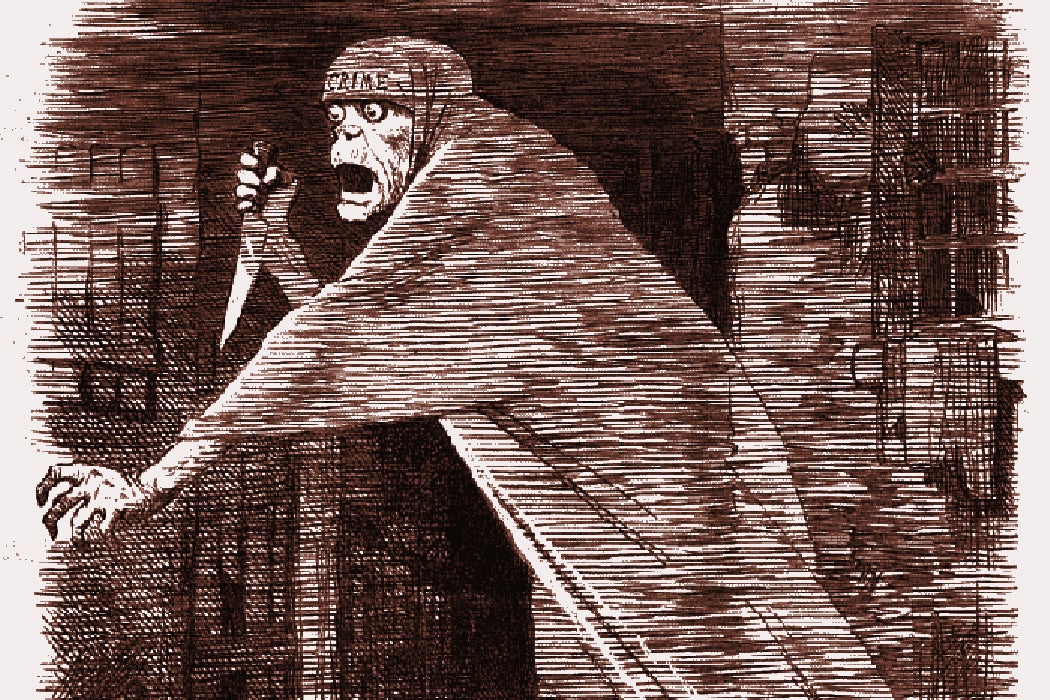On August 31, 1888, the body of forty-three-year-old Mary Ann “Polly” Nichols was found in Whitechapel, East London. She was the first of five murder victims attributed to Jack the Ripper, also known as the Whitechapel Murderer, Whitechapel Fiend, and Leather Apron—all names given by the press and/or the popular imagination. The never-identified killer (or was it killers?) terrorized, and titillated, late Victorian Britain for months.
Ever since, “the Ripper story has continued to provide a common vocabulary of male violence against women,” writes historian Judith R. Walkowitz about popular culture’s first serial killer phenomenon. This vocabulary’s “persistence owes much to the mass media’s exploitation of Ripper iconography—depictions of female mutilation in mainstream cinema, celebrations of the Ripper as a ‘hero’ of crime—that intensify the dangers of male violence and convince women that they are helpless victims.”
In her pioneering essay, Walkowitz “seeks to exorcise that ghost from women’s consciousness, by historicizing Jack the Ripper: by returning to the scene of the crimes and investigating how the story of Jack the Ripper was constructed out of the fissures and tensions of class, gender, and ethnic relations in 1888.”
The fissures were deep. Demonstrations and riots in 1886 and 1887 revealed the stark divide between wealthy West London and “Outcast London” (as the well-off called it) to the east. Whitechapel was already notorious for crime and misery. Like many slums, however, it was also a place of strong community. And, like many slums, the middle and upper classes came to it as thrill-seekers. Many suspected the Ripper’s true identity was a “toff” (or aristocrat) of some kind. (Also under suspicion were doctors, sailors, butchers, even midwives).
Also in the murky London air were sex scandals and an anti-prostitution campaign fired up by a sensational muckraking series called “Maiden Tribute of Modern Babylon.” The reform movement ended up making prostitutes more vulnerable to violence because they were forced to the streets when brothels were shut down. (The same 1885 law also outlawed “indecent” acts between consenting adult males, the basis of anti-homosexual prosecutions until 1967.)
Immigration panic also played a role. The murderer was called “Jacob the Ripper” by those trumpeting the anti-Semitic libel that Jews engaged in ritual murder. After Annie Chapman’s murder on September 8, 1888, the police sent hundreds of officers into the neighborhood to “forestall a possible pogrom.”
Want more stories like this one?
Walkowitz also reveals that the Ripper story “covertly sanctioned male antagonism toward women and buttressed male authority over them.” Husbands, lovers, strangers, vigilante gangs, slumming upper class men who claimed to be private detectives, and even little boys in the street, threatened girls and women Whitechapel-style. The initial Jack the Ripper letter and post card, believed by Walkowitz and others to be the work of an enterprising journalist, were the first of some three-hundred-and-fifty letters purporting to be from the killer. Imitation if not emulation was the order of the day.
Even “respectable women” in good neighborhoods were effectively under “house arrest” at night as the media speculation flared throughout the autumn of 1888. Walkowitz’s research was expanded into a book-length study about “narratives of sexual danger in late-Victorian London.” City of Dreadful Delight suggests that an intermingling of sensationalism, entertainment, and terror, erotic and otherwise, hovered through the fog and filthy air of Victoria’s metropolis.
The last of what Wikipedia calls the “canonical” murder victims of the Ripper—to distinguish them from earlier and later unsolved murders—was twenty-five year-old Mary Jane Kelly. She was killed on November 9, 1888. Though the cases were never solved, the concept of Jack the Ripper has lived on, in innumerable films, television shows, fictions, and more than a hundred non-fiction works.







